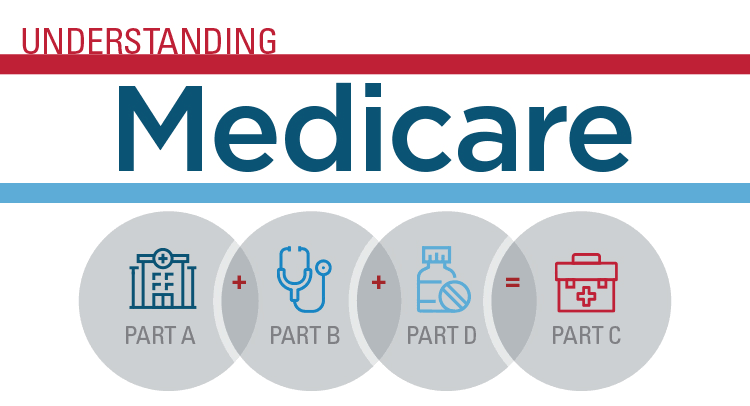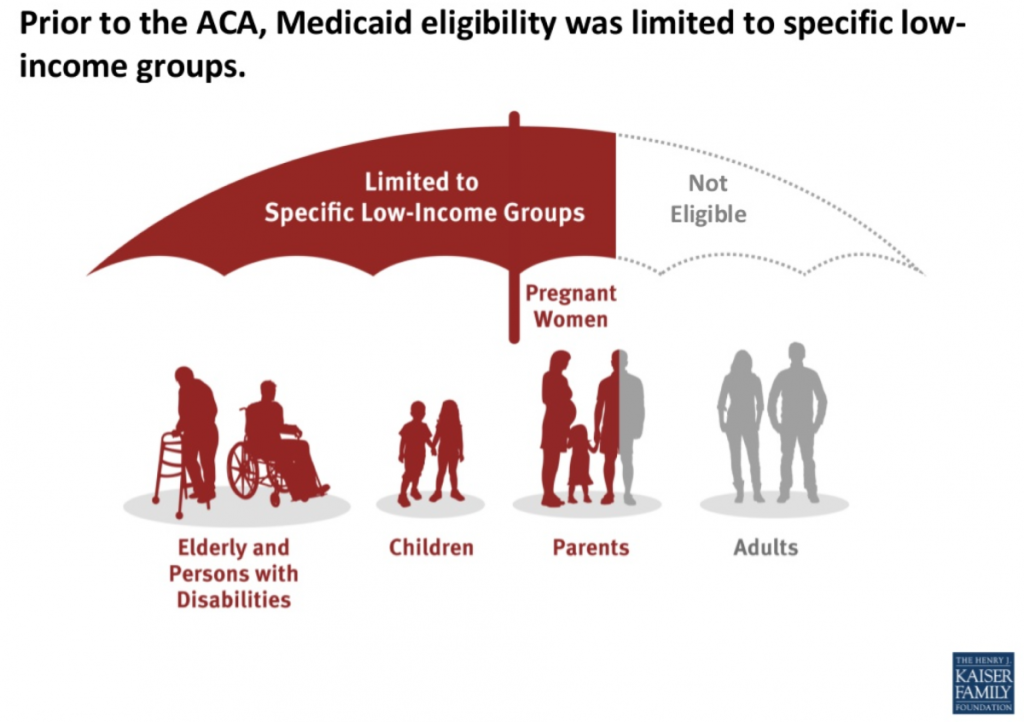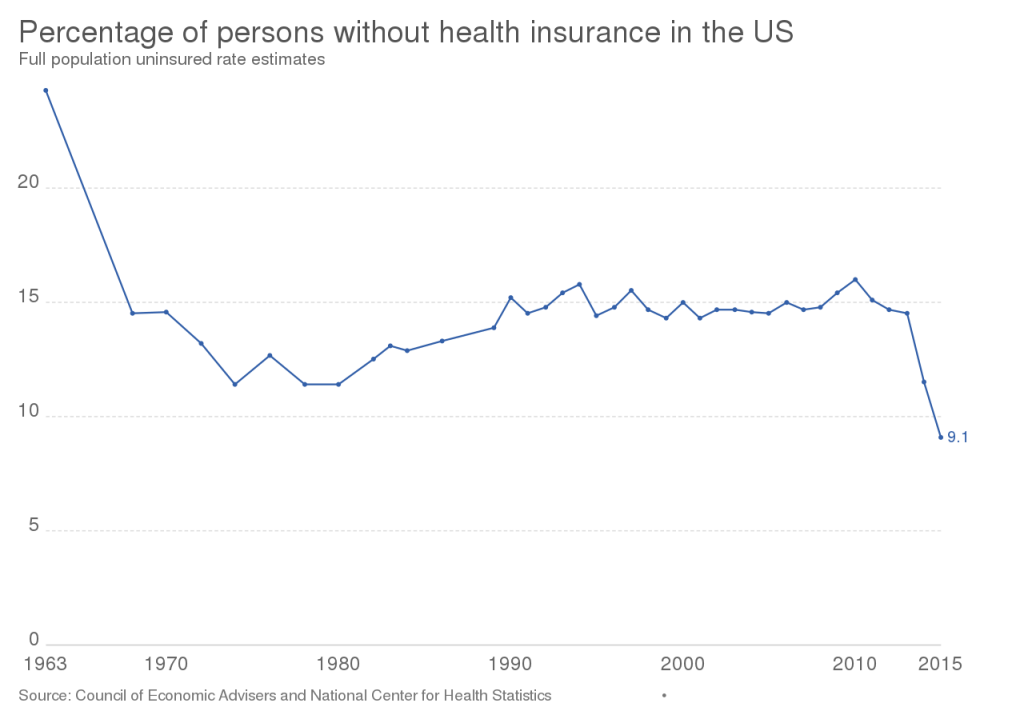8.3 Health Care Funding
Health care costs impact both macroeconomics (affecting the entire country and society as a whole) and microeconomics (affecting the financial decisions of businesses and individuals). Health care services are funded by several payment models, including federal government programs (e.g., Medicare and Medicaid), private health insurance (typically provided by employers), and self-pay. Payment models also impact services provided by health care agencies, as well as the services and medications available to consumers. Nurses must be aware of these payment models because of the impact on the allocation of resources they need to provide patient care.
Government Funding
In 1965 Medicare and Medicaid were signed into law. These programs provide eligible Americans support for their health care needs with taxpayer funding.
Medicare
Medicare is a federal health insurance program used by people aged 65 and older, younger individuals with permanent disabilities, and people with end-stage renal disease requiring dialysis or kidney transplant. Medicare coverage has four different components that cover different services: Part A, Part B, Part C, and Part D.[1] See Figure 8.6[2] for an image of Medicare coverages.
- Part A (Hospital Insurance): Part A covers patients’ hospital stays, care needed at a skilled nursing facility, hospice care, and some home health care. Part A is free for clients if they or their spouse paid Medicare taxes for a specific amount of time while working. If clients are not eligible for free coverage, they can buy it with premiums based on the number of months they paid Medicare taxes.
- Part B (Medical Insurance): Part B covers doctors’ services, outpatient care, medical supplies, and preventative care services. Most people pay a standard premium for Part B.
- Part C (Medicare Advantage Plan): Part C is a private health plan that consumers can purchase.
- Part D (Prescription Drug Coverage): Part D helps cover the cost of prescription drugs and vaccinations. To get Medicare drug coverage, clients must enroll in a Medicare-approved plan that offers drug coverage. Different plans vary in cost and what prescription medications they cover, also referred to as a formulary.

Read more about Medicare at medicare.gov.
Medicaid
Medicaid is the largest source of health coverage in the United States. It is a joint federal and state program covering eligible individuals with taxpayer funding. To participate in Medicaid, federal law requires states to cover certain groups of individuals, such as low-income families, qualified pregnant women and children, and individuals receiving Supplemental Security Income (SSI). States may choose to cover additional groups, such as individuals receiving home and community-based services and children in foster care who are not otherwise eligible.[3]
In 2014 the Affordable Care Act expanded Medicaid to cover all low-income Americans under the age of 65 years and also expanded coverage for children. Due to the individual states’ involvement in Medicaid, coverage of services varies from state to state.[4] See Figure 8.7[5] for an illustration of Medicaid-eligible populations.

Individuals with Medicaid plans have support in paying for a variety of health services, including hospital care, laboratory tests and diagnostic testing, skilled nursing care, home health services, preventative care, and regular outpatient provider visits.
Read more about Medicaid at medicaid.gov.
Other Government Health Funding
There are several other types of health coverage provided by federal and state programs. Read more about these programs in the following box.
Other Federal and State Health Care Funding Programs[6]
- State Children’s Health Insurance Program: A program designed to help provide coverage for uninsured children when their family’s income was below average but too high to qualify for Medicaid. The federal government provides matching funds to states for health insurance for these families.
- Read more details at InsuredKidsNow.gov.
- Children and Youth with Special Health Care Needs: This program coordinates funding and resources to provide care to people with special health needs.
- Read more details at Children with Special Health Care Needs.
- Tricare: This program covers about 9 million active duty and retired military personnel and their families.
- Read more details at TRICARE.
- Veterans Health Administration (VHA): This government-operated health care system provides comprehensive health services to eligible military veterans. About 9 million veterans are enrolled.
- Read more details at Veterans Health Administration.
- Indian Health Service: This system of government hospitals and clinics provides health services to about 2 million American Indians and Alaskan natives living on or near a reservation.
- Read more details at Indian Health Service.
- Federal Employee Health Benefits (FEHB) Program: This program allows private insurers to offer insurance plans within guidelines set by the government for the benefit of active and retired federal employees and their survivors.
- Read more details at The Federal Employees Health Benefits (FEHB) Program.
- Substance Abuse and Mental Health Services Administration (SAMHSA): This agency within the U.S. Department of Health & Human Services leads public health efforts to advance the nation’s behavioral health needs.
- Read more details at SAMHSA.gov.
- Refugee Health Promotion Program: This program provides short-term health insurance to newly arrived refugees.
- Read more details at Refugee Health Promotion Program (RHP)
Private Insurance
Individuals who are not eligible for government-funded health programs like Medicare or Medicaid can purchase private health insurance. Many individuals with private insurance obtain coverage through their employers’ benefit packages, where the costs for coverage are shared between the employer and the employee. If an individual does not receive health insurance through their employer, they may purchase it from the Marketplace established by the Affordable Care Act.
Read more about obtaining health insurance through the ACA Marketplace at healthcare.gov.
Self-Pay
Some individuals do not have health care coverage provided by their employer, do not qualify for Medicare or Medicaid, and do not elect to purchase health insurance coverage. Instead, these individuals go without coverage and pay health care costs as they arise. See Figure 8.8[7] for a graph illustrating the decreasing numbers of uninsured consumers in the United States over the past several decades. Unfortunately, due to the skyrocketing cost of health care services, significant bills can accrue from a single serious illness or traumatic injury that can put consumers without health care coverage in jeopardy of bankruptcy. Nurses can assist uninsured individuals to better understand coverage options by referring them to a case manager or social worker.

Types of Insurance Coverage
Health insurance plans have different types of coverage. Common types of health insurance plans are HMO, PPO, POS, HDHP, or HSA.
- Health Maintenance Organization (HMO): HMO plans usually have the lowest monthly cost for coverage (i.e., premium) but also have a smaller network of providers and hospitals where the consumer may receive insured care. This means the consumer is restricted to receive care only from specific providers and health facilities. Many HMOs also require the consumer to see their primary care provider to request a referral to see a specialist, which may or may not be approved by the HMO. Additionally, many tests, procedures, surgeries, and medications require “preauthorization” by the HMO, which may or may not be approved. Due to these restrictions, consumers may find they sacrifice flexibility and choice for lower cost of coverage.[8]
- Preferred Provider Organization (PPO): PPO plans are typically less restrictive than HMOs. PPOs typically include “in-network” providers and hospitals where costs are lower if care is received in-network, but consumers also have a choice to receive “out-of-network” care at a higher cost. Referrals from a primary care provider are not generally required in a PPO. The monthly premium for a PPO plan is typically higher than an HMO plan, but PPOs allow more consumer flexibility in choosing their health care providers.[9]
- Point of Service (POS): POS plans are a combination of HMO and PPO plans, where the insured consumer has a preferred provider network to receive health care services at a lower cost, but also has the flexibility to receive care outside of their network. When consumers venture outside of the network, they often have to pay a significant share of the cost.[10]
- High Deductible Health Plan (HDHP): HDHP plans are often popular for younger individuals without chronic health care needs who spend little on health care but require coverage in the event a high-cost injury or illness occurs. HDHPs typically have lower monthly premiums but require the individual to pay more upfront for health care services before the coverage kicks in (referred to as a “deductible”). Individuals with an HDHP often have an associated Health Savings Plan (HSA). HDHPs have grown in popularity as more employers offer these plans in an attempt to contain health care costs by shifting more cost-sharing to the consumer.
- Health Savings Plan (HSA): An HSA is a special account reserved for eligible medical expenses with strict usage rules. Money placed in an HSA can often be deducted from a consumer’s pretaxed pay, resulting in tax savings. In addition to purchasing items like glasses, contacts, and over-the-counter medications, HSAs can often be used to pay for deductibles. Some employers deposit a specified amount of money into an employee’s HSA every year to help reimburse high deductibles.
Deductible and Copays
Costs paid by an insured individual are commonly referred to as “out-of-pocket expenses.” Out-of-pocket expenses include deductibles and co-pays. A deductible is the amount of money a consumer pays before the health care plan pays anything. Deductibles generally apply per person per calendar year. For example, a High Deductible Health Plan may have a $5,000 deductible per person, whereas a PPO may have a $2,000 deductible per person. See Figure 8.9[11] for an image of a deductible.

A co-pay is a flat fee the consumer pays at the time of the health care service. For example, when visiting a primary provider, the consumer pays $20 to the provider at each visit. Some health care plans require co-pays in addition to deductibles.
Nursing Considerations
Understanding a client’s health insurance coverage is important because it may impact their choice of health services and their ability to purchase medications and other supplies. Additionally, if a client is self-pay, it is helpful to refer them to case managers or social workers who can explain how to obtain affordable health care coverage through the ACA Marketplace or other government programs.
- Medicare.gov. What’s Medicare? https://www.medicare.gov/what-medicare-covers/your-medicare-coverage-choices/whats-medicare ↵
- “Understanding_of_medicare.png” by Samreen Al is licensed under CC BY-SA 4.0 ↵
- Medicaid.gov. Eligibility. https://www.medicaid.gov/medicaid/eligibility/index.html ↵
- Healthcare.gov. Affordable Care Act. https://www.healthcare.gov/glossary/affordable-care-act/ ↵
- “Medicaid.expansion-1200x846.png” by KFF is licensed under CC BY-NC-ND 4.0 ↵
- Schreck, R. I. (2020, March). Overview of health care financing. Merck Manual Consumer Version. https://www.merckmanuals.com/home/fundamentals/financial-issues-in-health-care/overview-of-health-care-financing ↵
- “Percentage_of_persons_without_health_insurance_in_the_US,_OWID.svg” by Our World In Data is licensed under CC BY 3.0 ↵
- Small Business Majority. Coverage types. https://healthcoverageguide.org/reference-guide/coverage-types/ ↵
- Small Business Majority. Coverage types. https://healthcoverageguide.org/reference-guide/coverage-types/ ↵
- Small Business Majority. Coverage types. https://healthcoverageguide.org/reference-guide/coverage-types/ ↵
- “expensive-car-insurance.jpg” by unknown at QuoteInspector.com is licensed under CC BY-ND 4.0 ↵

